Selected Completed Projects
Evaluating movement of Chinook salmon between Lakes Michigan and Huron
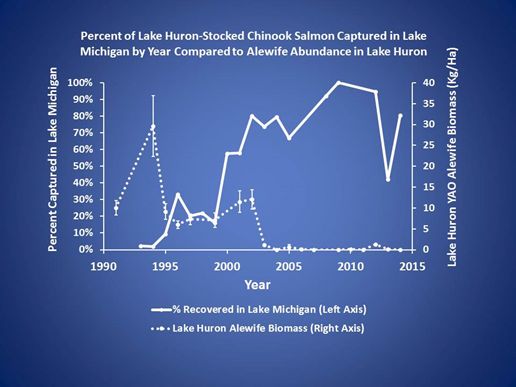
Goal/Purpose: To assess changes in inter-lake movement patterns of tagged Chinook salmon in relation to the collapse of alewives in Lake Huron.
Results/Conclusions: We analyzed capture locations of hatchery-reared Chinook salmon that were tagged and released in northern lakes Huron and Michigan from 1993–2014. We showed that the majority of fish released in Lake Huron shifted their feeding location from Lake Huron to Lake Michigan after the collapse of alewives in Lake Huron in 2003. On the other hand, fish released in Lake Michigan stayed in Lake Michigan. We estimated that the number of Chinook Salmon stocked in Lake Huron and utilizing the forage base of Lake Michigan could be as high as 0.6 million fish, which would be equivalent to increasing the stocking rate of Lake Michigan by 30%.
Management Usage: Stocking policies for Chinook Salmon in lakes Huron and Michigan will be coordinated to a greater degree in the future. Movements of Lake Huron fish will continue to be monitored with coded-wire tags and their impact on the forage base of Lake Michigan will be included in attempts to achieve predator-prey balance in that lake.
Funding Agency: Great Lakes Fishery Trust
QFC Staff: Rick Clark, Jim Bence, and Rene Reilly
External Collaborators: Randall M. Claramunt and John A. Clevenger (Michigan Department of Natural Resources), Matthew S. Kornis and Charles R. Bronte (U.S. Fish and Wildlife Service), Charles P. Madenjian and Edward F. Roseman (U.S. Geological Survey, Great Lakes Science Center).
Products: Clark, R.D. Jr., J.R. Bence, R.M. Claramunt, J.A. Clevenger, M.S. Kornis, C.R. Bronte, C.P. Madenjian, and E.F. Roseman. 2017. Changes in movements of Chinook salmon between Lakes Huron and Michigan after alewife population collapse. North American Journal of Fisheries Management 37:1311-1331.
Assist in implementation of the Predator-Prey Ratio Analysis (PPRA) in Lake Michigan
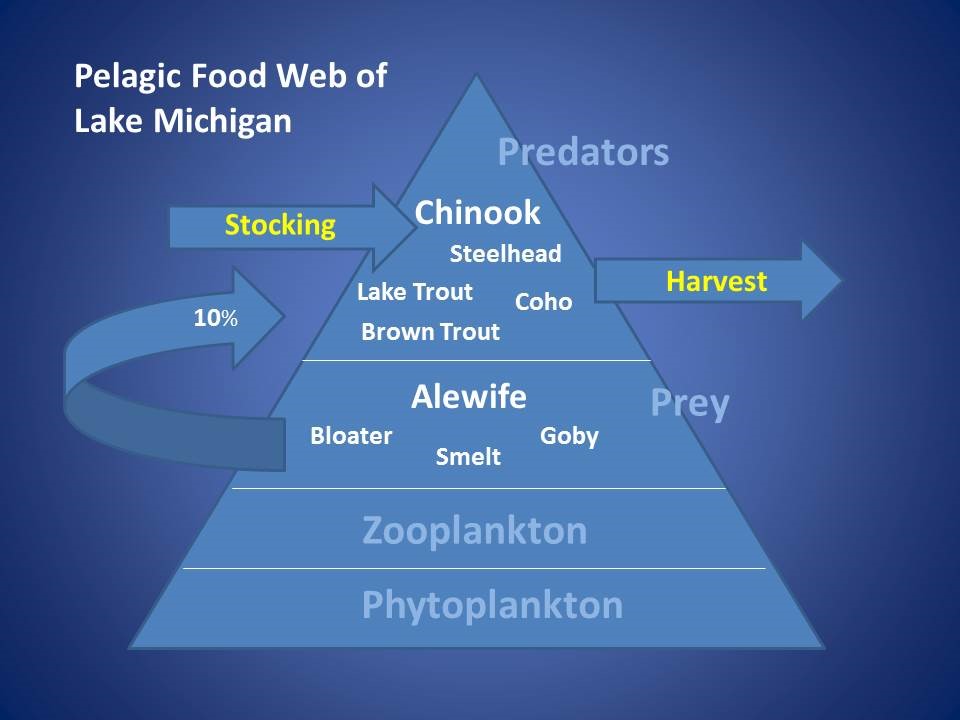
Goal/Purpose: To help the Lake Michigan Salmonid Working Group to make annual runs of the PPRA, including helping with interpretation of results and suggesting model improvements.
Results/Conclusions: Rick Clark and Mike Jones led development of the PPRA in workshops attended by members of the Salmonid and Planktivore Working Groups. It has become an important tool used by managers to help evaluate success of stocking policies in Lake Michigan.
Management Usage: The Chinook-alewife predator-prey ratio is estimated annually and compared to historical values and target and limit reference points, and thereby provides managers with feedback to help them decide whether to change stocking rates.
Funding Agency: Great Lakes Fishery Commission.
QFC Staff: Rick Clark, Mike Jones, and Iyob Tsehaye
External Collaborators: Members of the Lake Michigan Salmonid and Planktivore Working groups
Products:
Evaluation of sea-lamprey associated mortality sources on a generalized lake sturgeon population in the Great Lakes
Goal/Purpose: To create a lake sturgeon population model that incorporates two age-specific mortality 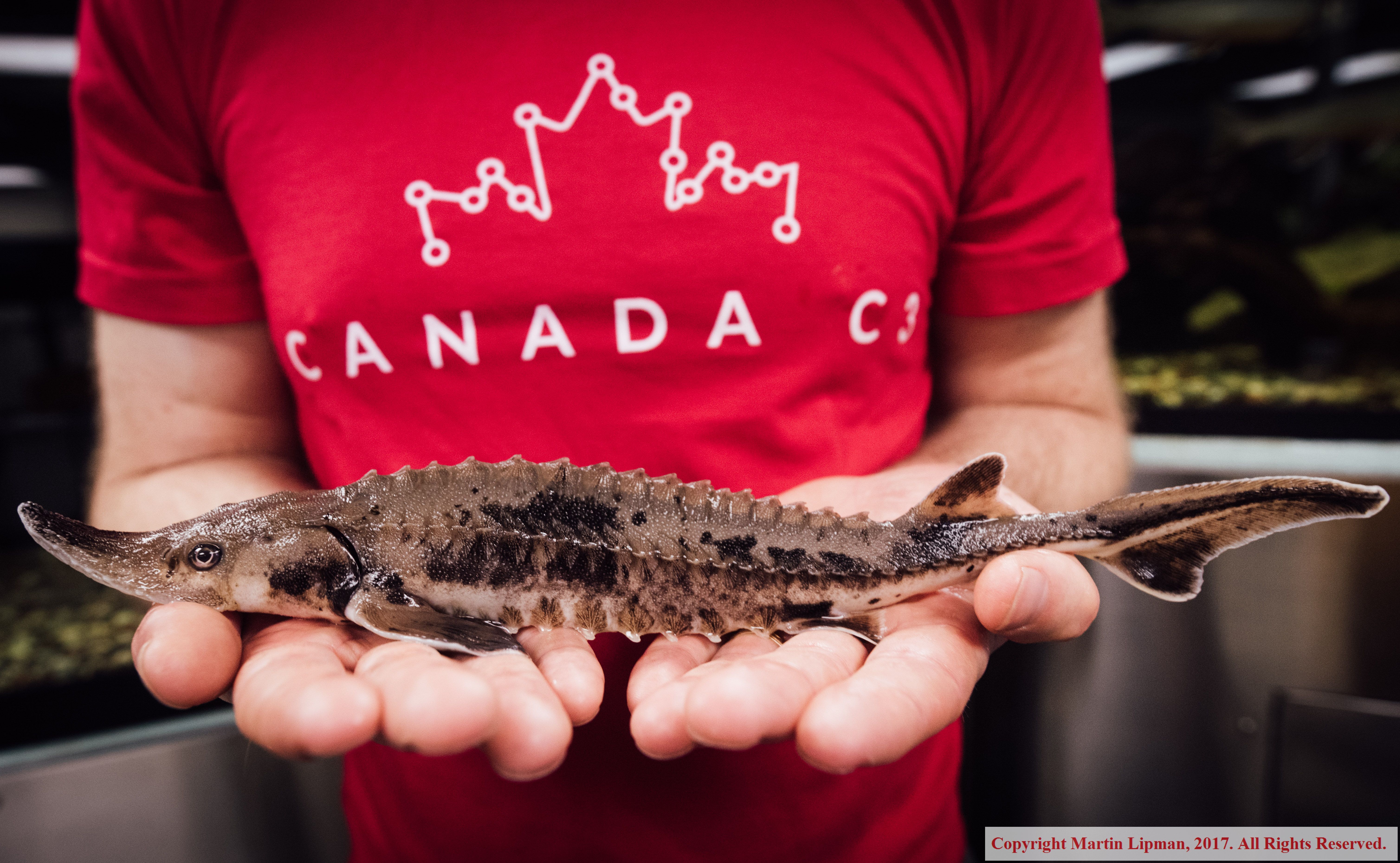 sources associated with sea lamprey, lampricide (TFM) exposure-induced mortality on age-0 fish and sea lamprey predation on sub-adults and adults, and evaluate what mortality source had a greater effect on lake sturgeon abundance and its potential influence on restoration efforts.
sources associated with sea lamprey, lampricide (TFM) exposure-induced mortality on age-0 fish and sea lamprey predation on sub-adults and adults, and evaluate what mortality source had a greater effect on lake sturgeon abundance and its potential influence on restoration efforts.
Results/Conclusions: The age-structured model showed that although lampricide-induced mortality on age-0 lake sturgeon can limit attainable population abundance, sea lamprey predation on sub-adult lake sturgeon may have a greater influence on abundance. Because each lake sturgeon population experiences unique environmental conditions and sea lamprey predation pressure, the modeling effort predicted that in some circumstances the absence of TFM toxicity could lead to a 5.7% increase in adult lake sturgeon populations. However, small increases in sea lamprey predation pressure could tip this balance leading to a 13% decrease in adult lake sturgeon abundance.
Management Usage: The modeling effort suggests that until such time as TFM toxicity on larval lake sturgeon can be reduced while simultaneously maintaining TFM toxicity on larval sea lamprey, fishery managers will need to balance the trade-off between lake sturgeon rehabilitation and allowing higher sea lamprey predation on the larger Great Lakes fish community.
Funding Agency: Great Lakes Fishery Commission
QFC Staff: Norine Dobiesz and Jim Bence
External Collaborators: Trent Sutton (University of Alaska), Mark Ebener (Chippewa-Ottawa Resource Authority), Tom Pratt (Fisheries and Oceans Canada), Lisa O'Connor (Fisheries and Oceans Canada), and Mike Steeves (Fisheries and Oceans Canada)
Products: Dobiesz, N.E., J.R. Bence, T. Sutton, M. Ebener, T.C. Pratt, L.M. O’Connor, and T.B. Steeves. 2018. Evaluation of sea lamprey-associated mortality sources on a generalized lake sturgeon population in the Great Lakes. Journal of Great Lakes Research 44:319-329.
Feasibility of stocking vaccinated hatchery fish to minimize disease spread in wild populations
Goal/Purpose: To use a spatially-explicit individual-based model evaluate the effectiveness of vaccinating hatchery-propagated fish as means 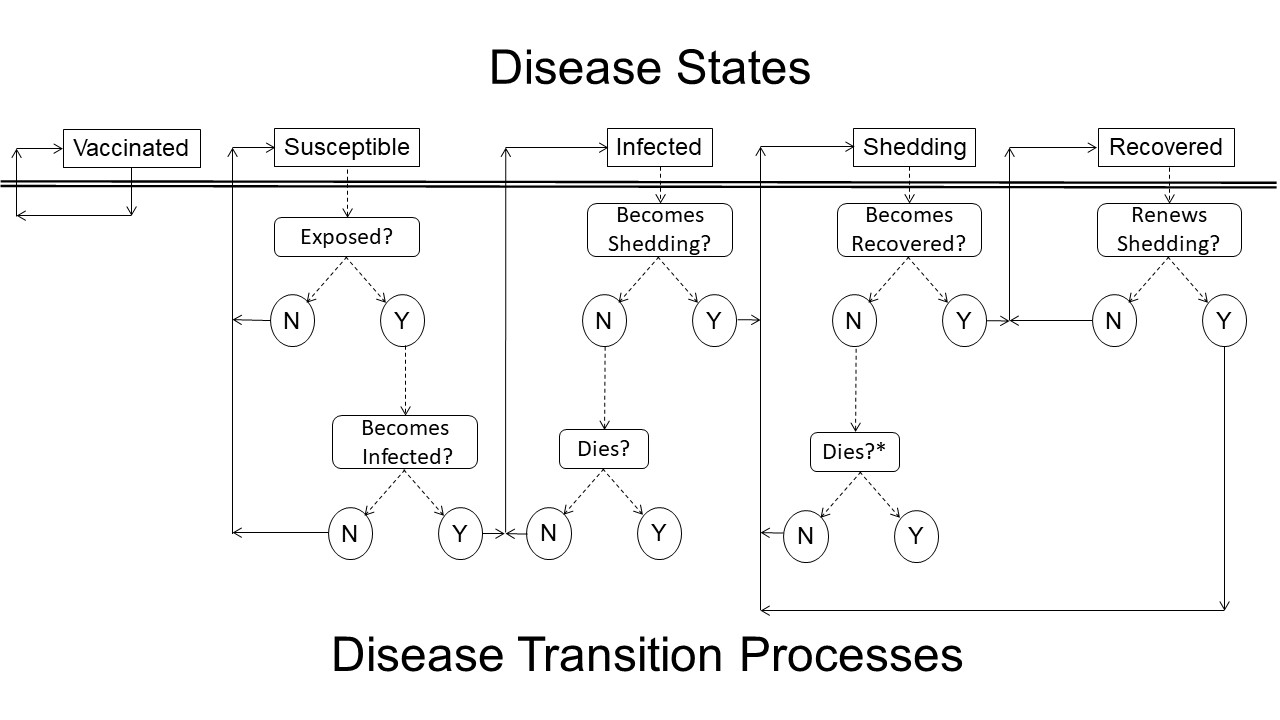 to protect wild Lake Michigan Chinook salmon against a disease exhibiting characteristics similar to viral hemorrhagic septicemia genotype IVb,
to protect wild Lake Michigan Chinook salmon against a disease exhibiting characteristics similar to viral hemorrhagic septicemia genotype IVb,
Results/Conclusions: Modeling results suggested that at typical Chinook salmon stocking levels and assuming that vaccination resulted in 100% life-time protection against the disease, vaccination could decrease the percent of the population infected with the disease by 23–74% per year depending on the factors evaluated. Complete disease eradication was only achieved if it was assumed previously infected individuals could not resume viral shedding.
Management Usage: The use of vaccination programs in aquatic settings has largely been limited to aquaculture/hatchery facilities, although interest in expanding vaccination programs to include protecting wild populations is expanding. The constructed model can be used as a framework for evaluation future vaccination programs on the Great Lakes.
Funding Agency: Great Lakes Fishery Trust
QFC Staff: Lori Ivan and Travis Brenden
External Collaborators: Mohamed Faisal (Michigan State University), Isaac Standish (Michigan State University)
Products: Ivan, L.N., T.O. Brenden, I.F. Standish, and M. Faisal. 2018. Individual-based model evaluation of using vaccinated hatchery fish to minimize disease spread in wild fish populations. Ecosphere 9:e02116.
Quantifying differences in otolith chemistry of Chinook salmon in Lake Michigan to determine natal origins
Goal/Purpose: To determine the feasibility of quantifying the movement of wild Chinook salmon from Lake  Huron to Lake Michigan using otolith microchemistry techniques.
Huron to Lake Michigan using otolith microchemistry techniques.
Results/Conclusions: Otoliths collected in 2015 and 2016 from juvenile and adult fish were analyzed for trace element concentrations, and the microchemical signatures were used to distinguish Chinook salmon natal sources. Juvenile otoliths reclassified to their natal origins with success at a basin level (Lake Michigan vs. Lake Huron) above 90%. Applying the juvenile models to classify adult otoliths achieved only moderate success, and further analyses indicated that inter-annual variation in otolith microchemical signatures was likely a factor in the decreased classification success.
Management Usage: The classification models developed as part of this research will be useful for calculating the movement of open-lake Chinook salmon. Future work should focus on refining these models to obtain more precise classification estimates. Ultimately, these models will will be used to assess risks associated with a variety of Chinook salmon stocking alternatives.
Funding Agency: Great Lakes Fishery Trust
QFC Staff: Alex Maguffee, Mike Jones, Rick Clark
External Collaborators: Matt Kornis (US Fish and Wildlife Service), Jory Jonas (Michigan Department of Natural Resources), Kevin Pangle (Central Michigan University), Carson Prichard (Central Michigan University), Nicole Watson (Central Michigan University), James Student (Central Michigan University)
Products:
Simulation analyses of integrated tagging and catch-at-age analysis models and application to Lake Erie walleye
Goal/Purpose: To investigate the performance of integrated tagging and catch-at-age analysis (ITCAAN) 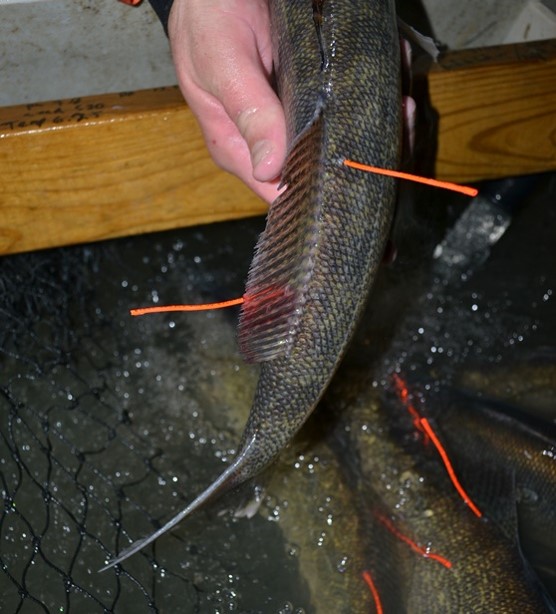 models and apply an appropriate model to data for walleye in Lake Huron, the Huron-Erie corridor and Lake Erie.
models and apply an appropriate model to data for walleye in Lake Huron, the Huron-Erie corridor and Lake Erie.
Results/Conclusions: Both release- and recovery-conditioned ITCAAN models had difficulty estimating individual population abundances and reporting rates under high rates of movement and large differences in population sizes. For both ITCAAN frameworks, estimation of both natural mortality and reporting rates reduced the accuracy and precision of model estimates, but estimates were less biased than
misspecifying one of these parameters by 50%. Release-conditioned ITCAAN models generally outperformed recovery-conditioned ITCAAN models under simulation scenarios patterned after Lakes Erie and Huron walleye dynamics.
Management Usage: This project provide an alternative assessment model that can be compared to the current assessment models used for management purposes in Lake Huron, the western and central basin of Lake Erie, and the eastern basin of Lake Erie. This assessment model could potentially be used for the management of walleye in the region or provide advise on how to conduct future tagging in the region to better suit the use of this model.
Funding Agency: Great Lakes Fishery Trust, Great Lakes Fishery Commission
QFC Staff: Matt Vincent, Travis Brenden, Jim Bence
External Collaborators: Dave Fielder (Michigan Department of Natural Resources), Todd Wills (Michigan Department of Natural Resources), Matt Faust (Ohio Department of Natural Resources), Jason Robinson (New York State Department of Environmental Conservation), Andy Cook (Ontario Ministry of Natural Resources and Forestry), Yingming Zhao (Ontario Ministry of Natural Resources and Forestry)
Products: Vincent, M.T., T.O. Brenden, and J.R. Bence. 2017. Simulation testing the robustness of a multi-region tag-integrated assessment model that exhibits natal homing and estimates natural mortality and reporting rate. Canadian Journal of Fisheries and Aquatic Sciences 74:1930-1949.



 Print
Print Email
Email